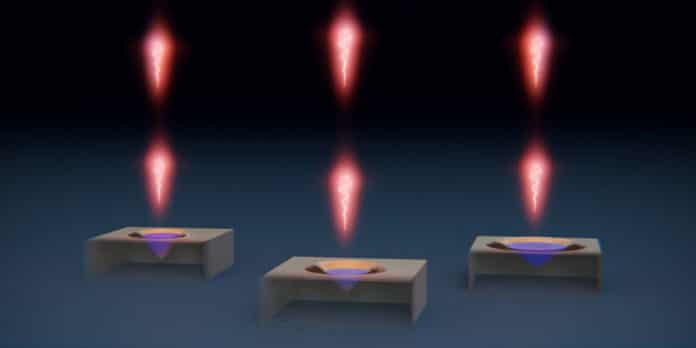Many technologies are designed using quantum mechanics. Such technologies are based on exactly equal photons. However, it isn’t easy to generate such photons. They must have precisely the same wavelength (color), same shape, and matching polarization.
A team of scientists led by Richard Warburton at the University of Basel, in collaboration with colleagues at the University of Bochum, has successfully produced identical photons with different quantum dots. They created identical photons originating from different and widely-separated sources.
Quantum dots (QDs) are semiconductor particles a few nanometres in size, having optical and electronic properties that differ from larger particles due to quantum mechanics. In the quantum dots, electrons are trapped so that they can only take on very specific energy levels.
When moving from one level to the next, light is emitted. Single photons can be manufactured at the touch of a button using a laser pulse that induces such a transition.
Liang Zhai, a postdoctoral researcher and first author of the study recently published in Nature Nanotechnology, said, “In recent years, other researchers have already created identical photons with different quantum dots. To do so, however, from a huge number of photons, they had to pick and choose those that were most similar using optical filters.”
Scientists chose a different approach: They produced extremely pure gallium arsenide from which the quantum dots were made. As a result, inherent differences between quantum dots might be maintained to a minimum. The Basel physicists used Electrodes to expose two quantum dots to finely tuned electric fields. These fields changed the quantum dots’ energy levels and were adjusted so that the photons released by the quantum dots all had the same wavelength.
Scientists used a half-silvered mirror to demonstrate that the photons were truly indistinguishable. They noticed that the light particles nearly always traveled through the mirror as a pair or were reflected as a pair. Based on this finding, they could deduce that the photons were 93 percent identical. In other words, even though the photons were “born” entirely independently of one another, they created twins.
Scientists also realized an essential building block of quantum computers: the so-called controlled-NOT gate (or CNOT gate). Such gates can be used to implement quantum algorithms that can solve specific problems much faster than classical computers.
Ph.D. student Giang Nguyen said, “Right now, our yield of identical photons is still around one percent. However, we already have a rather good idea of how to increase that yield in the future. That would prepare the twin-photon method for potential applications in different quantum technologies.”
Journal Reference:
- Zhai, L., Nguyen, G.N., Spinnler, C. et al. Quantum interference of identical photons from remote GaAs quantum dots. Nat. Nanotechnol. (2022). DOI: 10.1038/s41565-022-01131-2
